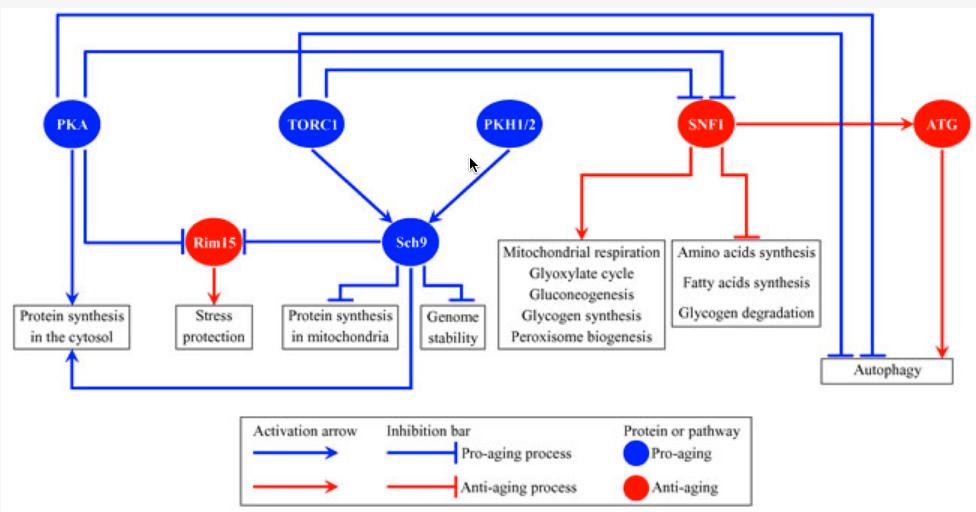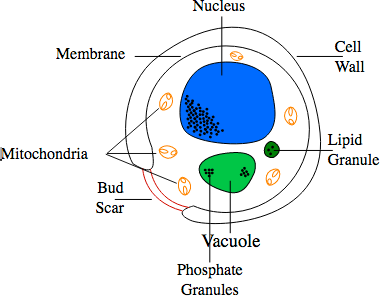These six plant extracts could delay aging
September 16, 2016

Several nutrient- and energy-sensing signaling pathways and protein kinases converge into a network that defines the rate of yeast chronological aging (credit: Vicky Lutchman et al./Oncotarget)
Six previously identified plant extracts can delay aging by affecting different signaling pathways that set the pace of growing old, researchers from Concordia University and Idunn Technologies have found, in a study recently published (open-access) in Oncotarget.
Using yeast — a favored cellular aging model — Vladimir Titorenko, a biology professor and the study’s senior author, and his colleagues conducted a screen of a library of 35 different plant extracts (PEs) to determine those that can extend yeast chronological lifespan. To do that, they monitored how the information flowing through signaling pathways was affected. They identified six aging-delaying plant extracts: Cimicifuga racemosa, Valeriana officinalis L., Passiflora incarnata L., Ginkgo biloba, Apium graveolens L., and “particularly effective”: Salix alba, commonly known as white willow bark.

Diagram of yeast cell (credit: Frankie Robertson/CC)
Anti-aging pathways
At a cellular level, aging progresses similarly in yeast and humans. In both, the pace of aging is defined by a distinct set of chemical reactions arranged into several “signaling pathways” that regulate the rate of aging in a wide range of organisms.
“It’s known that some of these signaling pathways delay aging if activated in response to certain nutrients or hormones,” Titorenko says. “These pathways are called ‘anti-aging’ or ‘pro-longevity’ pathways. Other signaling pathways speed up aging if activated in response to certain other nutrients or hormones. These pathways are called ’pro-aging’ or ‘pro-death’ pathways.” Each of the six aging-delaying plant extracts targets a different anti-aging or pro-aging signaling pathway.
The study revealed several features of the six plant extracts as potential tools in decelerating chronic symptoms and diseases of old age:
- They imitate the aging-delaying effects of the caloric restriction diet in yeast
- They slow yeast aging by eliciting a mild stress response
- They extend yeast longevity more efficiently than any lifespan-prolonging chemical compound yet described
- They delay aging through signaling pathways implicated in age-related diseases
- One of them delays aging via a previously unknown pathway
- They extend longevity and delay the onset of age-related diseases in organisms other than yeast
Health Canada classifies the six plant extracts as safe for human consumption, and recommends five of them as health-improving supplements with clinically proven benefits.
The study was supported by grants from the Natural Sciences and Engineering Research Council of Canada and the Fonds québécois de la recherche sur la nature et les technologies.
UPDATE Sept. 19, 2016: the six aging-delaying plant extracts’ names added.
Abstract of Six plant extracts delay yeast chronological aging through different signaling pathways
Our recent study has revealed six plant extracts that slow yeast chronological aging more efficiently than any chemical compound yet described. The rate of aging in yeast is controlled by an evolutionarily conserved network of integrated signaling pathways and protein kinases. Here, we assessed how single-gene-deletion mutations eliminating each of these pathways and kinases affect the aging-delaying efficiencies of the six plant extracts. Our findings imply that these extracts slow aging in the following ways: 1) plant extract 4 decreases the efficiency with which the pro-aging TORC1 pathway inhibits the anti-aging SNF1 pathway; 2) plant extract 5 mitigates two different branches of the pro-aging PKA pathway; 3) plant extract 6 coordinates processes that are not assimilated into the network of presently known signaling pathways/protein kinases; 4) plant extract 8 diminishes the inhibitory action of PKA on SNF1; 5) plant extract 12 intensifies the anti-aging protein kinase Rim15; and 6) plant extract 21 inhibits a form of the pro-aging protein kinase Sch9 that is activated by the pro-aging PKH1/2 pathway.